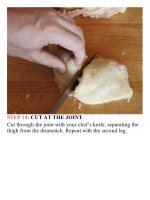The food lab better home cooking through science ( PDFDrive ) 114
Bạn đang xem bản rút gọn của tài liệu. Xem và tải ngay bản đầy đủ của tài liệu tại đây (205.32 KB, 2 trang )
HARD-BOILEDEGGS
Hard-boiled eggs are a little more complicated.The goal is
tohaveboththewhiteandyolkatthepointwheretheyare
opaque but not rubbery.The truly obsessive kitchen nerd’s
way to do it is to maintain the water at precisely 170°F so
that the yolk comes out perfectly cooked and the white is
stilltender.Andthismethodworks.It’salsoamajorpainin
thebutt.Luckily,there’saneasierway.
We already know that if we drop the eggs directly into
boiling water, the exterior heats up much faster than the
interior, so that by the time the very center of the yolk
reaches 170°F, the white and outer layers of yolk are
hopelessly overcooked. You might be inclined to put the
eggsincoldwaterandbringthemtoaboilgradually.This
method works, but there’s a problem: it causes the eggs to
fusetotheshells.
So, cooking them gently gives you even results, but
cookingthemfastmakesiteasiertoremovetheshell.What
Ineededwasatechniquethatbridgedbothofthese.Whatif
Iweretostarttheeggsinaprecisevolumeofboilingwater
andletthemcookjustlongenoughsothatthewhitessetbut
remainseparatedfromtheshells,thenlowerthetemperature
of the water rapidly by adding a few ice cubes and finish
cookingthem?
It took a few dozen tries to get the exact timing and ice
measurementsdowncorrectly,butguesswhat?Itworks.By
usingafaststartandaslow-and-steadycooktotheend,you
consistentlygeteggsthatarebothperfectlycookedthrough
andthroughandeasytopeel.









